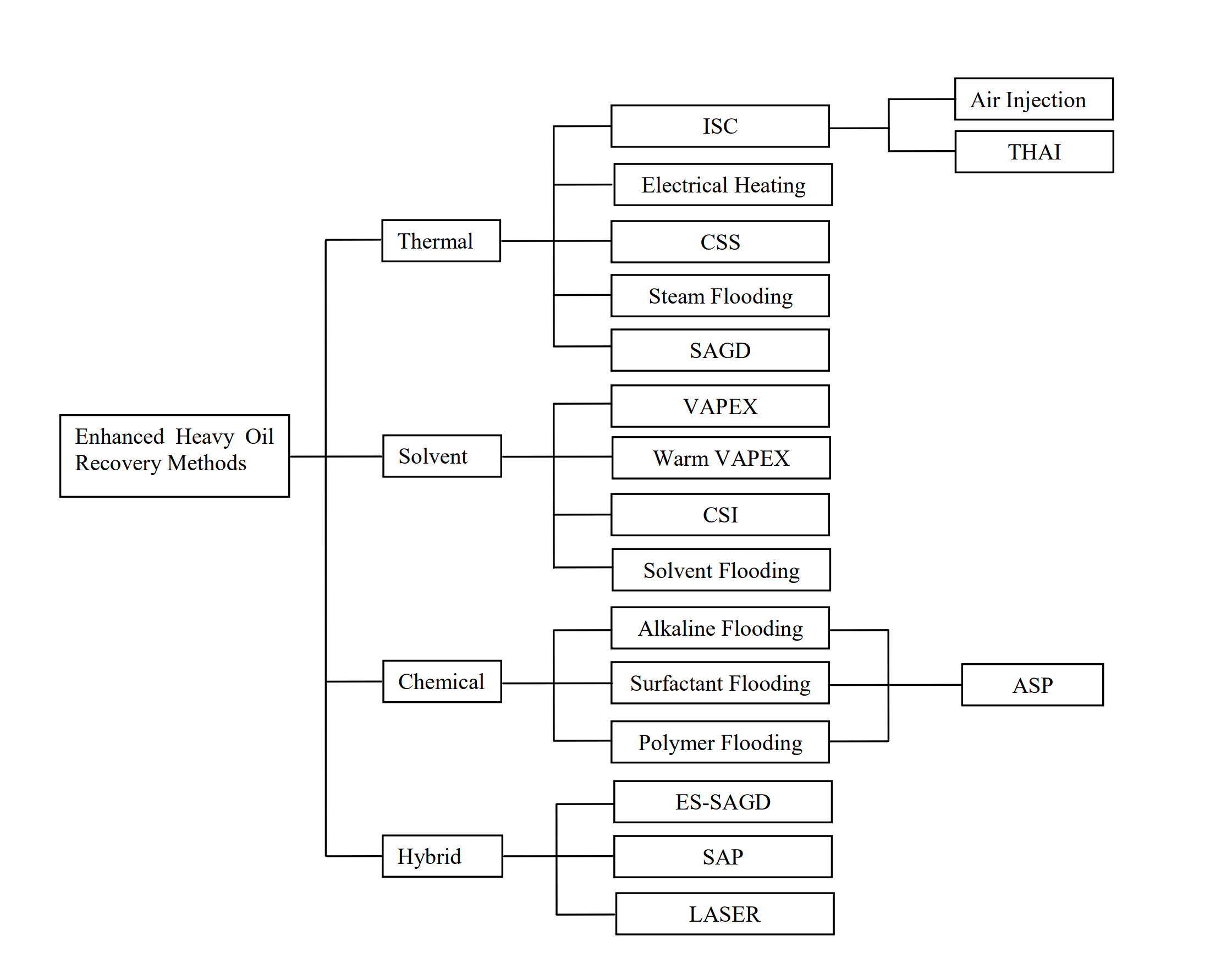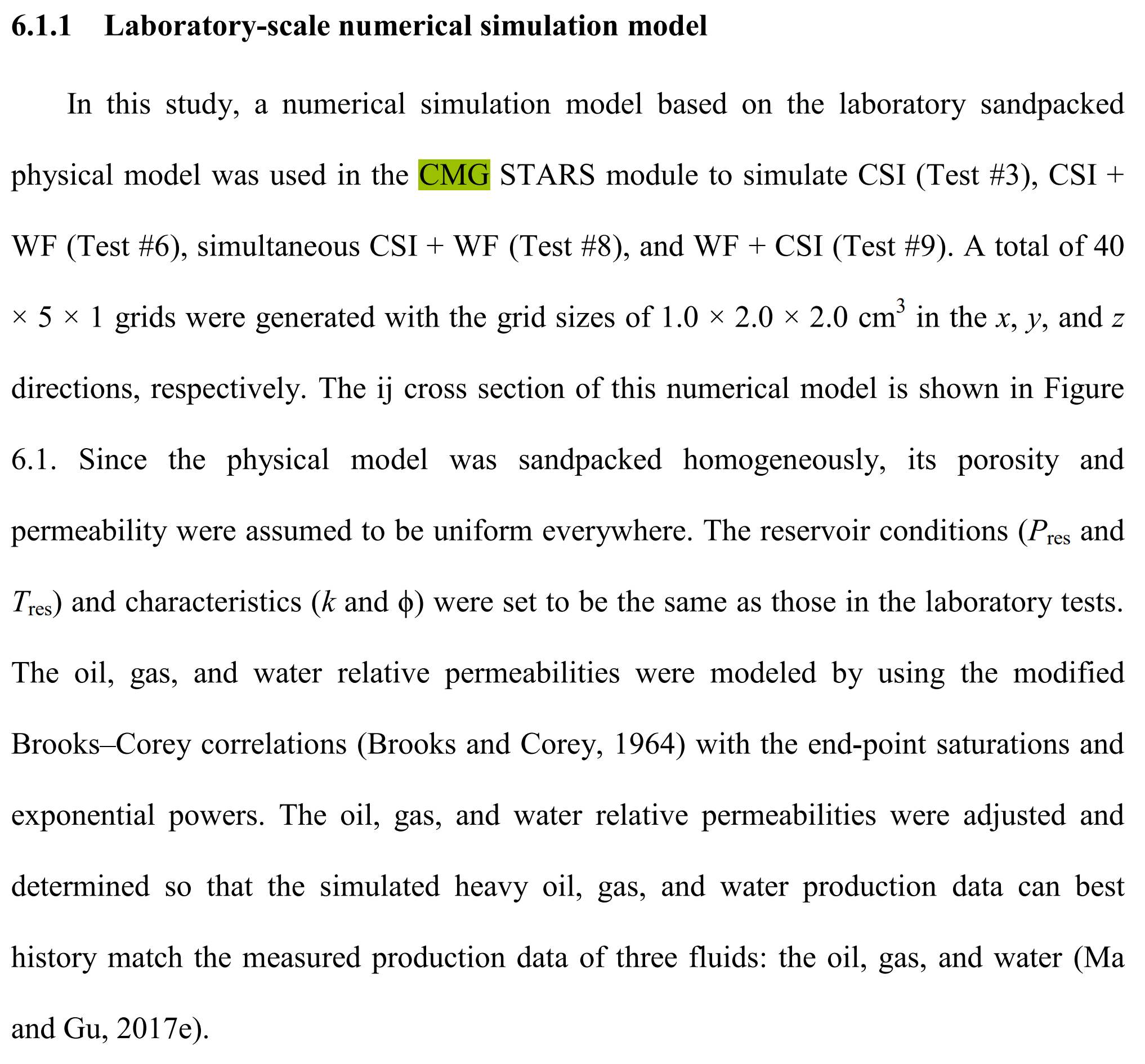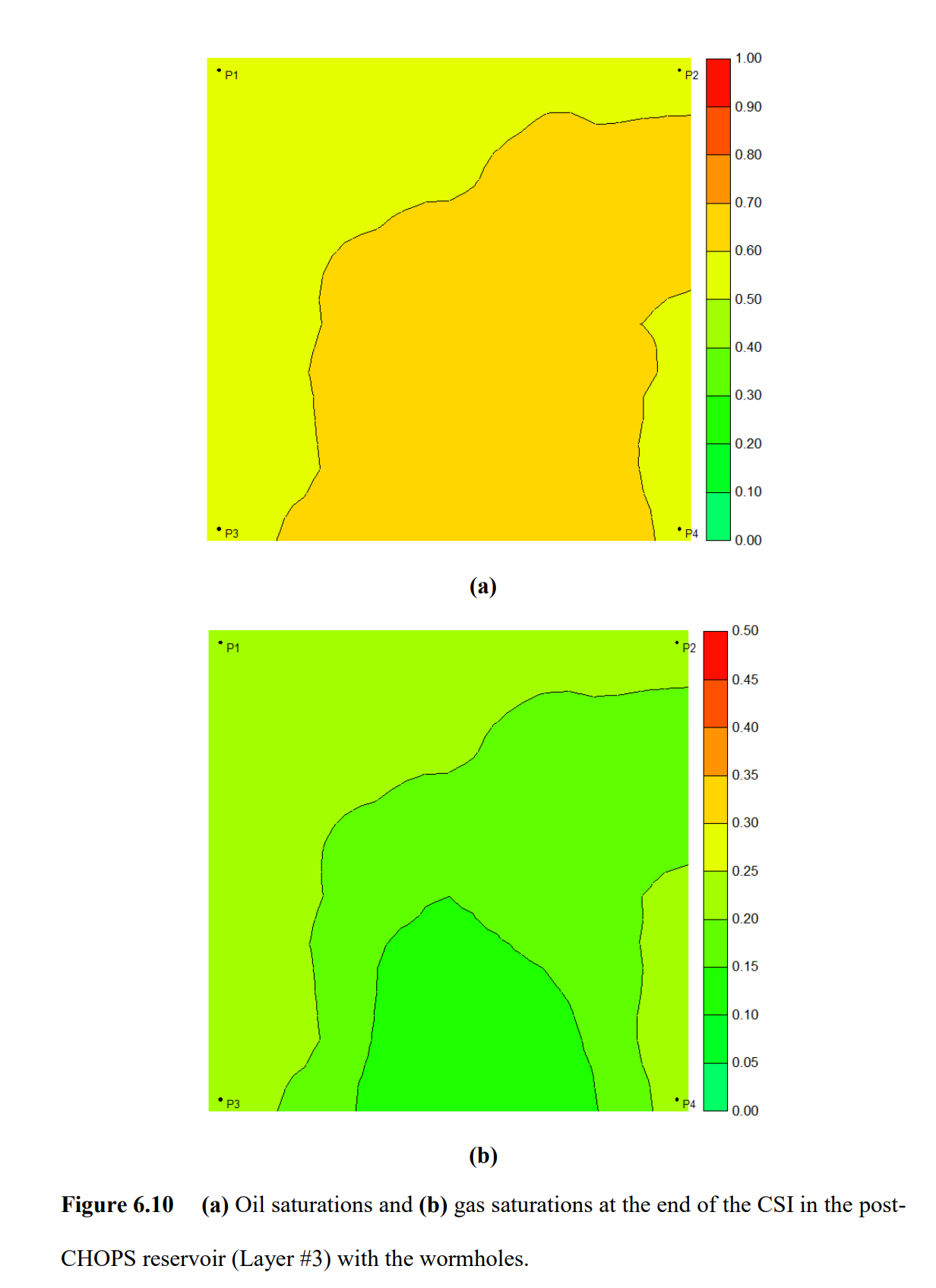本论文针对后稠油出砂冷采(CHOPS),探索了在两井配置下,采用循环溶剂注入(CSI)与水驱(WF)或气驱(GF)相结合的技术协同。在实验中,原始重油样品采集自加拿大阿尔伯塔省的柯罗尼组和迈凯轮组。测定了CH4/CO2/C3H8饱和柯罗尼/迈凯轮稠油在不同平衡压力和Tres=21°C下的PVT数据和粘度。共进行了17次填砂实验室试验,以检验组合CSI和WF/GF的技术和经济优势。CSI+WF和CSI+GF均比CSI或WF单独采出更多的稠油,这是由于泡沫油流的扩展。组合CSI和WF在重油采收率(RF)、重油产量和累积气油比(GOR)方面优于组合CSI和GF,因为随后注入的水阻碍了气窜。此外,由于C3H8具有更好的PVT性质和更大的稠油降粘作用,因此它比CO2更适合溶解和萃取。在CSI或GF期间,中压压降速率或CO2注入速率导致较高的稠油RF。
OPTIMUM CYCLIC SOLVENT INJECTION (CSI) AND WATERFLOODING/GASFLOODING IN THE POST COLD HEAVY OIL PRODUCTION WITH SAND (CHOPS) RESERVOIRS

从理论上建立了一个分析物质平衡模型(MBM),用于预测初次开采和后续CSI期间的累计稠油和天然气产量以及平均储层压力。分析中考虑了非平衡相行为和泡沫油性质。通过理论预测数据与实验测量数据的最佳拟合,调整并确定了稠油中溶解CH4的成核系数和稠油中分散CH4气泡的衰减系数等未知参数。预测的初次开采和后续CSI期间的累计稠油产量和平均储层压力与实测数据吻合较好。然而,由于CSI的气窜效应,CSI的预测累积产气量与实测累积产气量之间存在较大差异,这是CSI遇到的一个重大技术问题。此外,研究还发现,当成核系数越大、压降速率越大或稠油粘度越小时,稠油中溶解的CH4越容易形成分散的CH4气泡。当压降增大或稠油粘度增大时,衰减系数越小,CH4气泡分散的泡沫稠油越稳定。
以净现值(NPV)为目标函数,对一个具有代表性的综合油田规模稠油油藏进行了初产后CSI、CSI+WF和CSI+GF的优化数值模拟。采用最速上升法(SA)和粒子群算法(PSO)求解最优井控方案,使NPV最大。SA方法和PSO方法均能有效地确定有/无蚯蚓洞稠油油藏CSI、CSI+WF和CSI+GF的近优NPV。研究发现,CSI+GF的净现值在后库普油藏最高。在整个储层寿命期间,产油器应在最低允许井底压力(BHP)下运行。气体注入井应在早期循环中以最大允许注入速率注入,但在后期循环中应关闭,以控制气窜。
ABSTRACT
In this thesis, the technical synergy of combining cyclic solvent injection (CSI) and waterflooding (WF) or gasflooding (GF) in a two-well configuration for the post-cold heavy oil production with sand (CHOPS) reservoirs was explored. In the experiments, the original heavy oil samples were collected from the Colony and McLaren formations in Alberta, Canada. The PVT data and viscosities of CH4/CO2/C3H8-saturated Colony/McLaren heavy oil were measured at different equilibrium pressures and Tres = 21 °C. A total of 17 sandpacked laboratory tests were conducted to examine the technical and economical merits of the combined CSI and WF/GF. Both the CSI + WF and CSI + GF recovered more heavy oil than the CSI or WF alone due to the extended foamy-oil flow. The combined CSI and WF outperformed the combined CSI and GF in terms of the heavy oil recovery factor (RF), heavy oil production rate, and cumulative gas‒oil ratio (GOR) because gas channeling was hindered by the subsequently injected water. In addition, C3H8 was found to be a more dissolving and extracting solvent than CO2 due to its more favorable PVT properties and larger heavy oil viscosity reduction. The intermediate pressure drawdown rate or CO2 injection rate resulted in a higher heavy oil RF during the CSI or GF.
Theoretically, an analytical material balance model (MBM) was formulated to predict the cumulative heavy oil and gas productions and the average reservoir pressure during the primary production and subsequent CSI. The non-equilibrium phase behaviour and the foamy-oil properties were taken into account in this analytical MBM. Several unknown parameters were tuned and determined by best matching the theoretically predicted data and the experimentally measured data, such as the nucleation coefficient of dissolved CH4 in the heavy oil and the decay coefficient of dispersed CH4 bubbles from the heavy oil. The predicted cumulative heavy oil productions and average reservoir pressures during the primary production and subsequent CSI agreed well with the measured data. However, there were large discrepancies between the predicted and measured cumulative gas productions in the CSI because of its gas channeling, which is a major technical issue encountered in the CSI. In addition, it was found that dissolved CH4 in the heavy oil became the dispersed CH4 bubbles more quickly when the nucleation coefficient was larger at a higher pressure drawdown rate or in a less viscous heavy oil. The foamy heavy oil with the dispersed CH4 bubbles was more stable when the decay coefficient was smaller at an increased pressure drawdown rate or in a more viscous heavy oil.
Numerical simulations were undertaken to optimize the CSI, CSI + WF, and CSI + GF after the primary production in a representative and synthetic field-scale heavy oil reservoir by choosing the net present value (NPV) as an objective function. The steepest ascent (SA) method and the particle swarm optimization (PSO) were utilized to find the optimum well controls and maximize the NPV. Both the SA method and PSO efficiently determined nearly optimum NPVs for the CSI, CSI + WF, and CSI + GF in the heavy oil reservoirs with/without the wormholes. It was found in this study that the NPV of the CSI + GF was the highest in the post-CHOPS reservoir. The oil producer should be operated at the minimum allowable bottom hole pressure (BHP) during the entire reservoir life. The gas injector should be used to inject at the maximum allowable injection rate during the early cycles but shut in during the late cycles to control the gas channeling.

Enhanced heavy oil recovery methods (Lin et al., 2014b)




